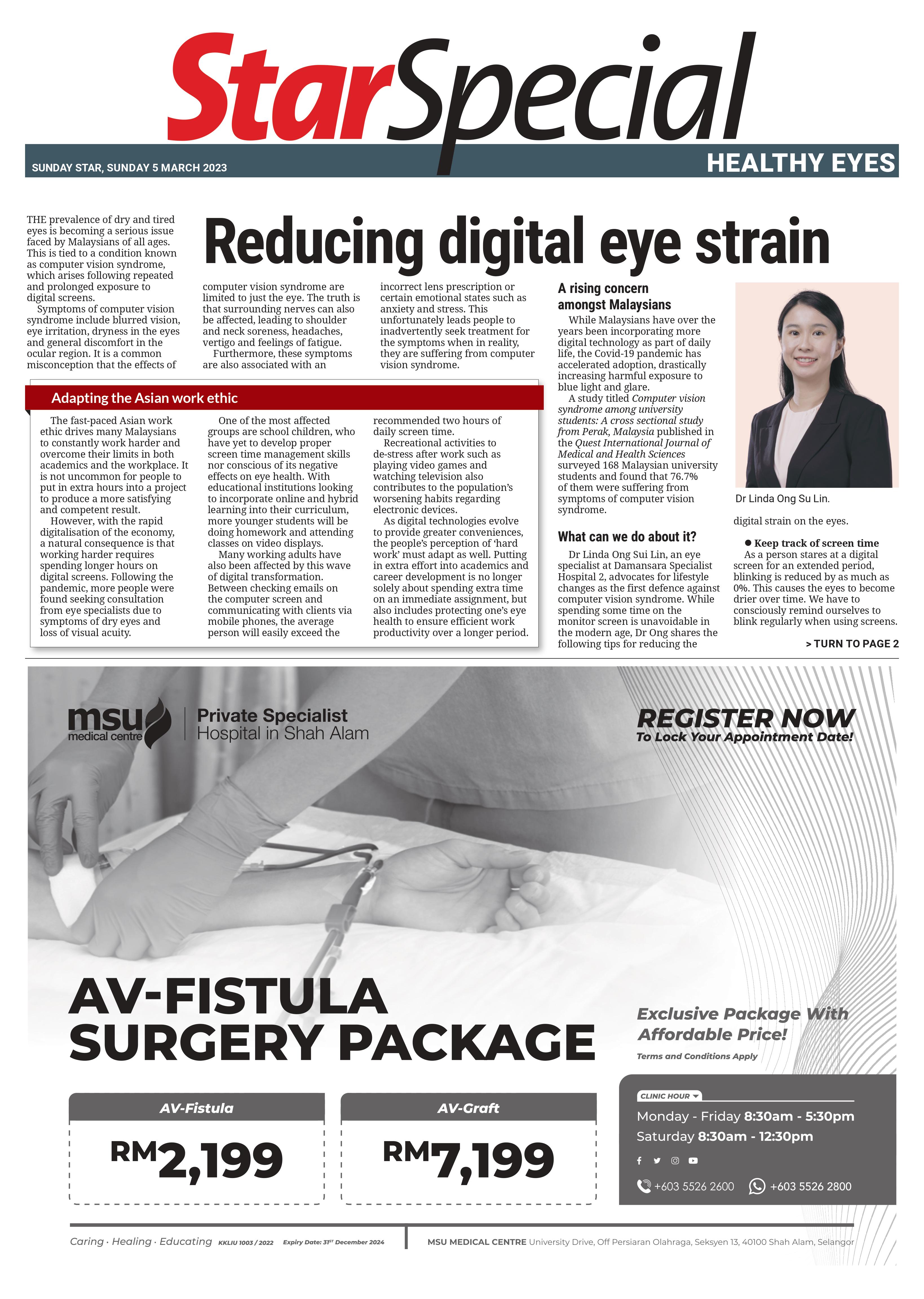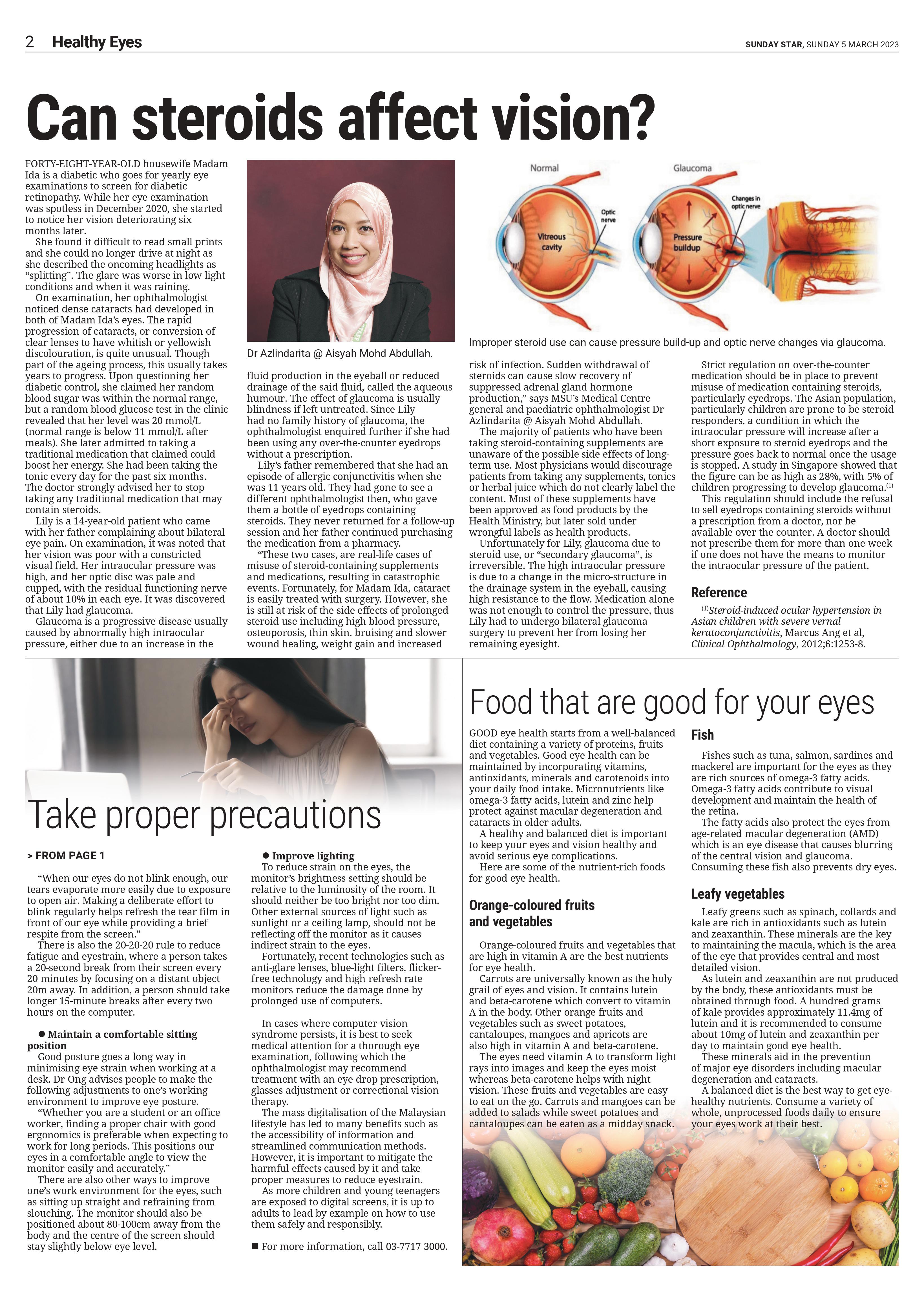Healthy Eyes: Reducing Digital Eye Strain

Healthy Eyes: Reducing Digital Eye Strain
THE prevalence of dry and tired eyes is becoming a serious issue faced by Malaysians of all ages. This is tied to a condition known as computer vision syndrome, which arises following repeated and prolonged exposure to digital screens.
Symptoms of computer vision syndrome include blurred vision, eye irritation, dryness in the eyes and general discomfort in the ocular region. It is a common misconception that the effects of computer vision syndrome are limited to just the eye. The truth is that surrounding nerves can also be affected, leading to shoulder and neck soreness, headaches, vertigo and feelings of fatigue.
Furthermore, these symptoms are also associated with an incorrect lens prescription or certain emotional states such as anxiety and stress. This unfortunately leads people to inadvertently seek treatment for the symptoms when in reality, they are suffering from computer vision syndrome.
A Rising Concern Amongst Malaysians
While Malaysians have over the years been incorporating more digital technology as part of daily life, the Covid-19 pandemic has accelerated adoption, drastically increasing harmful exposure to blue light and glare.
A study titled Computer vision syndrome among university students: A cross sectional study from Perak, Malaysia published in the Quest International Journal of Medical and Health Sciences surveyed 168 Malaysian university students and found that 76.7% of them were suffering from symptoms of computer vision syndrome.
What can we do about it?
Dr Linda Ong Sui Lin, an eye specialist at Damansara Specialist Hospital 2, advocates for lifestyle changes as the first defence against computer vision syndrome. While spending some time on the monitor screen is unavoidable in the modern age, Dr Ong shares the following tips for reducing the digital strain on the eyes.
Keep track of screen time
As a person stares at a digital screen for an extended period, blinking is reduced by as much as 0%. This causes the eyes to become drier over time. We have to consciously remind ourselves to blink regularly when using screens.
“When our eyes do not blink enough, our tears evaporate more easily due to exposure to open air. Making a deliberate effort to blink regularly helps refresh the tear film in front of our eye while providing a brief respite from the screen.” There is also the 20-20-20 rule to reduce fatigue and eyestrain, where a person takes a 20-second break from their screen every 20 minutes by focusing on a distant object 20m away. In addition, a person should take longer 15-minute breaks after every two hours on the computer.
Maintain a comfortable sitting position
Good posture goes a long way in minimising eye strain when working at a desk. Dr Ong advises people to make the following adjustments to one’s working environment to improve eye posture. “Whether you are a student or an office worker, finding a proper chair with good ergonomics is preferable when expecting to work for long periods. This positions our eyes in a comfortable angle to view the monitor easily and accurately.”
There are also other ways to improve one’s work environment for the eyes, such as sitting up straight and refraining from slouching. The monitor should also be positioned about 80-100cm away from the body and the centre of the screen should stay slightly below eye level.
Improve lighting
To reduce strain on the eyes, the monitor’s brightness setting should be relative to the luminosity of the room. It should neither be too bright nor too dim. Other external sources of light such as sunlight or a ceiling lamp, should not be reflecting off the monitor as it causes indirect strain to the eyes.
Fortunately, recent technologies such as anti-glare lenses, blue-light filters, flicker-free technology and high refresh rate monitors reduce the damage done by prolonged use of computers. In cases where computer vision syndrome persists, it is best to seek medical attention for a thorough eye examination, following which the ophthalmologist may recommend treatment with an eye drop prescription, glasses adjustment or correctional vision therapy.
The mass digitalisation of the Malaysian lifestyle has led to many benefits such as the accessibility of information and streamlined communication methods. However, it is important to mitigate the harmful effects caused by it and take proper measures to reduce eyestrain. As more children and young teenagers are exposed to digital screens, it is up to adults to lead by example on how to use them safely and responsibly.
Source: The Star Special
For more information, contact 03-7717 3000.





 Promotion
Promotion
 Find Doctor
Find Doctor


